Hunting Elk in Grizzly Country
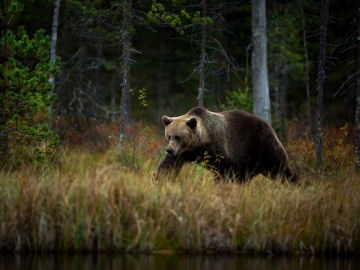

A pinecone drops to the ground with a soft thud. A calm breeze causes a branch to brush against the side of the tent. A mouse scurries across the tarp. In the daylight, none of these common elk camp events cause any need for worry. In the dark of night, however, these sounds – and our accompanying imaginations – become amplified. Set up your elk camp in grizzly country, and these sounds have been the cause of more sleepless nights than many of us care to admit.
I remember my first elk hunting trip into grizzly bear country. We opted to stay in a Forest Service campsite, complete with bear-proof food boxes, bear-proof dumpsters, and a concrete outhouse whose steel door bore the permanent scars left behind by the long, sharp claws of a grizzly – on the inside of the outhouse!
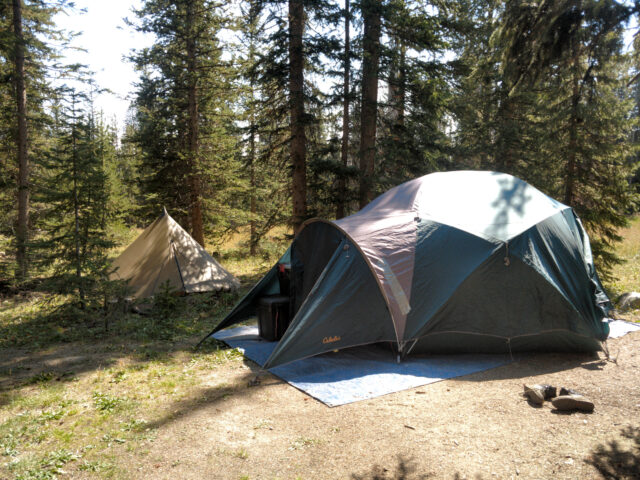
Camping in a bear-wise campground would remove one of our primary concerns with hunting elk in grizzly country, which in turn would allow us to get a good night’s rest. We had even brought along a bear fence, just for added reassurance.
That reassurance was undermined slightly though, when we found that the bear fence was about 2 feet short of stretching all the way around the perimeter of the tent – a requirement for electrical connectivity. No worries. All of the other campsite precautions would be more than adequate.
As we retired to the tent on that first night, all of our anticipation was focused on the elk we would be hunting in a few short hours. However, it didn’t take long for that focus to change.
A pinecone dropped to the ground with a soft thud. Was that the sound of a padded footstep? I held my breath in the pitch-black darkness, straining to hear more. A calm breeze escorted a tree branch along the side of the tent, brushing the rain fly every so slightly. If that is a bear, he is close. The breeze faded and the branch retreated, again brushing back along the side of the tent. The resulting sound resembled the breathing of an animal, just a few inches from my head. I hadn’t exhaled in over a minute, afraid that the sound of the sleeping bag settling as my chest sank from an exhaled breath would prevent me from hearing another movement from outside the tent. Or worse, alert the bear that something was alive on the inside of the tent. Just then, a mouse scurried across the tarp we had placed under the tent to provide protection to the tent floor. My mind immediately conjured up a detailed image of that soft, padded bear foot stepping onto the tarp as the sensitive nose of the bear pressed against the side of the tent. Still I held my breath.
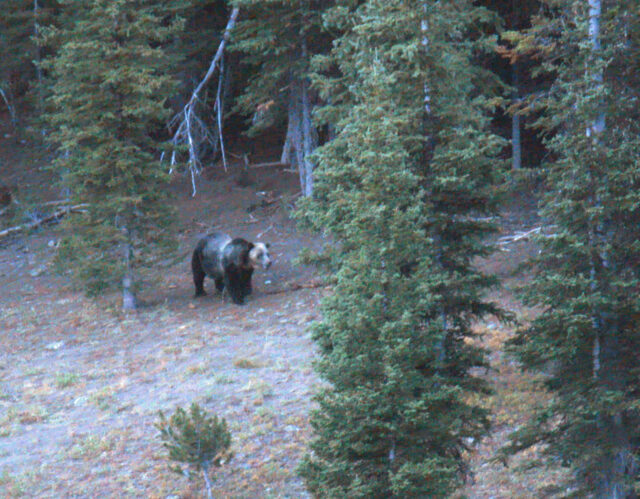
It was only when the mouse scurried back across the tarp that I realized I wasn’t in danger, and finally allowed the air I had been desperately holding within to escape my lungs. I had survived the first 5 minutes of camping in bear country, but with my senses now on full alert, every audible bump in the night was accompanied by an imagined threat lurking just outside the tent. I nearly drifted off to sleep 2 or 3 times, only to be brought back to full alert by a tree creaking or by a hunting partner shifting in his sleeping bag. A light, restless sleep was all I was able to manage those first few nights, but by the third night – and with no grizzly bear encounters – I was sleeping like I normally do in elk camp.
Since that first foray into grizzly country, I’ve managed to talk my hunting partners into several more trips to hunt elk in similar areas. And those first couple of nights are always accompanied by a heightened sense of our surroundings, which means a couple nights of less-than-average sleep quality.
Hunting and camping in grizzly bear habitat brings several challenges, but it can also come with many benefits. While it definitely takes an extra amount of preparation and caution, fewer people feel comfortable hunting in these areas, often reducing the hunting pressure and sometimes even increasing the odds of drawing a tag. And while the risk is always present, there are a few things you can do to drastically reduce the chances of an encounter with a bear.
There are three main areas where you could have issues with a grizzly bear while hunting elk: in camp, while hunting/hiking, and post-success. Since each area comes with different risks and precautions, I’ll break them out separately below.
In Camp
Bears have incredibly sensitive noses, and they are always hungry and always looking for an easy meal. Most encounters with bears in camp are typically the result of food or food odors. It’s critical that these odors are minimized or eliminated. If a bear doesn’t smell food in your camp, the chances of an unwanted visit go down dramatically. Here are a few safety suggestions to implement in camp to reduce your chances of an encounter:
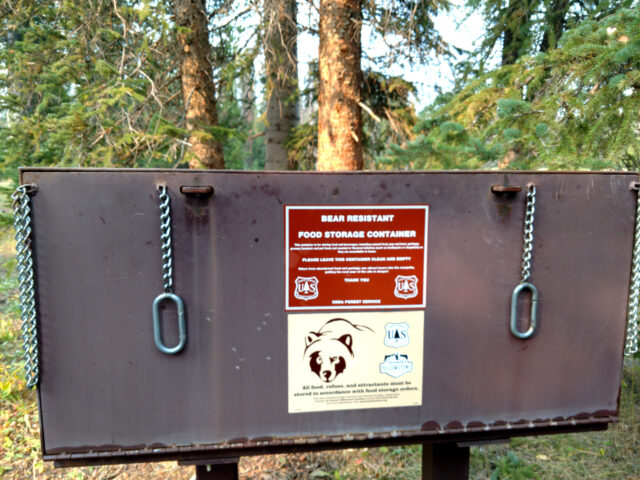
- Store (and cook) your food away from your main camp/sleeping area. There isn’t a magic distance, but if a bear does find your food and decides he wants it, I’d rather have him 60 yards or more away from my tent. As I mentioned previously, we’ve utilized USFS campsites with bear-proof food storage containers in the past. While these will definitely keep a bear from getting into your food, they are often just 15-20 feet away from the tent site. I prefer to move my food farther away from camp, and pull it up into a tree, rather than simply stashing it in a bear-proof box. If you opt for this method, be sure your food is high enough a bear can’t reach it (at least 10 feet up), and whenever possible, try to keep the food out and away from the trunk of the tree. This will help keep other climbing animals from getting into your food as well. Lastly, use an air-tight dry bag or something similar to store your food in, as this will cut down on scent, which is what a bear uses to find food.
- Keep your camp area clean. Like, spotless clean. Something as simple as a granola bar wrapper can put off enough odor to attract a grizzly bear, so pick up EVERYTHING. If you end up with garbage that you can’t get rid of, treat it like your food. Hang it in a tree away from camp. Definitely don’t ever leave a partially eaten – or even an empty – Peak Refuel meal tucked in next to your sleeping bag. Eat outside your tent, and don’t bring food into your tent with you.
Hunting/Hiking
While it can be unnerving to consider the thought of having a grizzly bear come into your hunting camp, detailed attention to a couple of simple camp precautions will drastically cut down on the chances of that happening. When we step into the woods, however, we almost immediately violate the rules of safety simply by the nature of what we are doing. Most bear precautions for hiking revolve around not surprising a bear – make lots of noise, hike with the wind at your back, etc. But as hunters, we are trying to do just the opposite. We do our best to stay quiet, and to make sure that nothing in front of us smells us or sees us coming. Then, we also throw in some cow and calf elk sounds – sounds that are meant to imitate one of the bear’s primary food sources. However, despite putting ourselves in a potentially dangerous situation, there are still a few things hunters can do to reduce the chances of an unwanted encounter with a grizzly bear while hunting:
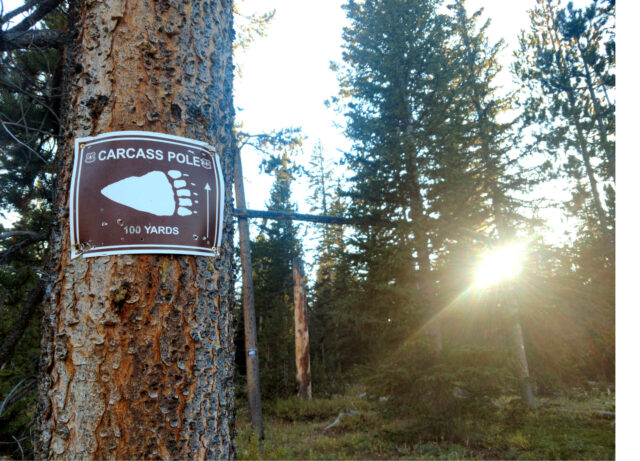
- Watch for bear sign. It might seem obvious, but if you’re seeing a lot of fresh grizzly activity in an area, it might be best to hunt somewhere else. You will always see bear sign when you are hunting in grizzly country, but if you find yourself on a north-face filled with ripe huckleberries or walking along a game trail in a willow-filled creek bottom that is littered with fresh tracks and fresh scat, you might consider an alternate area or path. Hike in areas where you will be less likely to surprise an otherwise shy bear, such as along open ridges. And if you do spot a bear in the area you are hunting, go the opposite direction.
- Consider sleeping in. It’s hard to do, but rather than hiking for long distances in the dark, if you’re able to access your hunting areas in the daylight, your odds of surprising a bear go down considerably. That doesn’t mean sleep in until 9:00 a.m., but if you at least wait until you can start to see in the morning, you – and the bear – gain the advantage of seeing what’s standing in the trail ahead of you.
- Be prepared to use a deterrent. And don’t just carry bear spray or a sidearm – practice drawing and deploying it. Grizzly bears are fast! Most times, if you surprise a bear, you will do so at close quarters. And if a bear decides you are a threat, they usually don’t take much time to react. A bear that is surprised at 40 yards away can be on top of you in less than 3 seconds. Drawing your bear spray or firearm and executing an effective shot need to become second-nature. I recently attended a rifle shooting competition put on by Sig Sauer, and one of the bonus targets was a charging grizzly bear that had to be shot with a sidearm. The bear started at 35-40 feet away, and was connected to a very fast pulley system that pulled the target straight at you in a very short amount of time. With the pistol already in hand and ready to fire, all we had to do was turn 90 degrees and try to empty the 3 rounds that were in the magazine. As fast as we could spin and start pulling the trigger, the 3rd shot was usually fired just as the target was falling at our feet. Coincidentally, it was often only that 3rd shot that actually connected with the target. At less than 4 feet away, I’m not sure that even a well-placed shot would be enough to help you avoid contact with a charging bear.
- If you are using calls, use them wisely. Set up so that you are protected from behind (against a tree, etc.), and where you can see anything that might be approaching from in front of you. Call, and then listen intently. I would avoid calling as I was hiking, and instead, get set up to do the calling. Don’t get too excited on the calls – if your cow calls sound more like a distressed calf than a passive cow, you might be asking for trouble.
Post-Success
For a grizzly bear that is preparing for a long winter hibernation, protein and fat are key components to their diet. And with a sense of smell that is around 2000-times stronger than that of a human, a bear can smell fresh meat from several miles away. Once they get a whiff of a fresh food source, it doesn’t take them long to arrive on the scene. And just like the previous 2 areas where a grizzly bear encounter is a possibility, there are some things to consider to avoid a confrontation with a hungry bear once you’ve killed an elk.
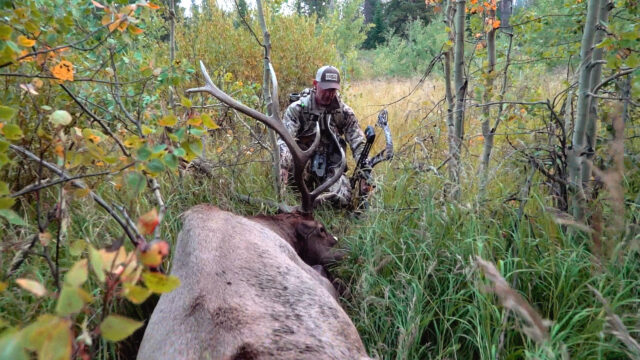 If you are tracking an elk, pay attention! Don’t get so focused on the bloodtrail that you walk right into the lap of a grizzly bear that has already claimed your elk. Go slow and quiet, and stop to listen often. If you are hunting with a partner, have one person focused on the bloodtrail, and the other close behind 100% focused on watching up ahead (for the elk and/or a bear).
If you are tracking an elk, pay attention! Don’t get so focused on the bloodtrail that you walk right into the lap of a grizzly bear that has already claimed your elk. Go slow and quiet, and stop to listen often. If you are hunting with a partner, have one person focused on the bloodtrail, and the other close behind 100% focused on watching up ahead (for the elk and/or a bear).- And if you are hunting with a partner, get to work immediately once you find the elk and have one person stand guard to watch for a bear moving toward the carcass. Bears can move very silently, and if you have your head down focused on quartering the elk, a bear could be on top of you without any warning.
- Make some noise. I’m not saying you need to pull out pots and pans and start banging on them to ward off bears, but you are done hunting. It’s OK to make some noise. Talk, or do something that will let a bear know you are there so if it does decide to come in, it might not be taken completely by surprise. Making noise might not be enough to deter a bear from coming to the dead elk, but it may be enough to prevent a surprise attack and give you enough time to back away to safety.
- Elk are huge-bodied animals, but if your elk falls in a thicket and you are able to drag it at all, move it out into the open. Dragging an elk more than 8-10 feet usually takes 2-3 able-bodied hunters, but do whatever you can to avoid working up the elk in thick vegetation. We had to drag an elk 30-40 feet out of some thick timber a years back, and while it was incredibly difficult, having that elk 20-30 feet out onto an open hillside provided a much safer environment for getting the elk quartered up and into game bags.
- Once you get the elk into game bags, hang the quarters a good distance away from the carcass. Again, it’s difficult to provide an exact distance, but farther is better than close. And, if you are able to hang the quarters in a tree that you can see from a distance as you approach the quarters on return trips, that is ideal. Make sure you have enough paracord to pull the quarters high enough into the tree that a bear can’t reach them. If it’s at all difficult for the bear to get to the quarters, he’ll usually move on to the carcass which is much easier to access.
- If a bear is on your elk, the elk is now his. Don’t even try to run the bear off your carcass. Once they claim it, they will usually never give it up, and you are putting yourself in a very dangerous situation.
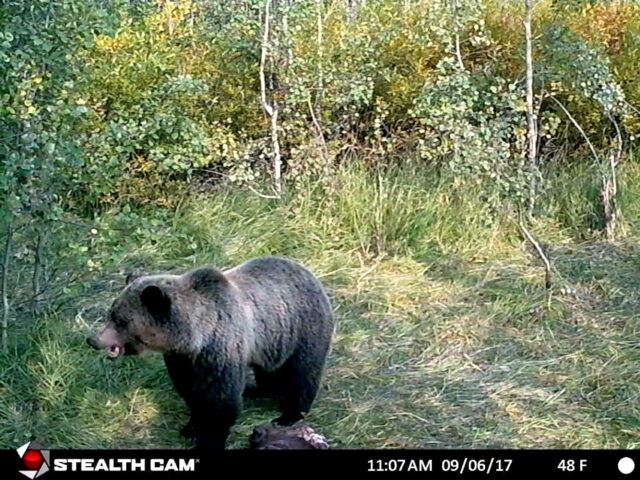
Conclusion
Again, hunting elk in grizzly bear country does come with some risks. However, with a little planning and extra effort while in the field, you can greatly decrease the odds of an encounter with a bear. Most bear attacks are due to surprising an unsuspecting bear – especially a female bear with cubs. Keep a clean camp, keep your head on a swivel while you are hunting, and work quickly to get the meat off the carcass and moved to a safe location a good distance away, and the odds will be in your favor.
One more consideration I didn’t mention previously is the possibility of unknowingly stumbling into someone else’s elk carcass while you are out hiking. If the carcass has been there longer than 24 hours, there’s a good chance a grizzly bear could be on it. There isn’t a whole lot you can do to avoid this, but if your hunting partner happens to kill an elk, hunt somewhere else for the rest of your hunt. Additionally, I prefer to hunt earlier in the season if I’m going to hunt in grizzly country. The earlier in the season I hunt, the fewer carcasses there will be scattered around the area, and the lower my chances of running into a bear on someone else’s carcass. Lastly, don’t put a trail camera on an elk carcass to capture video or pictures of grizzlies, and then wait until dusk on the last day of the hunt to retrieve it. Just trust me on that one…

